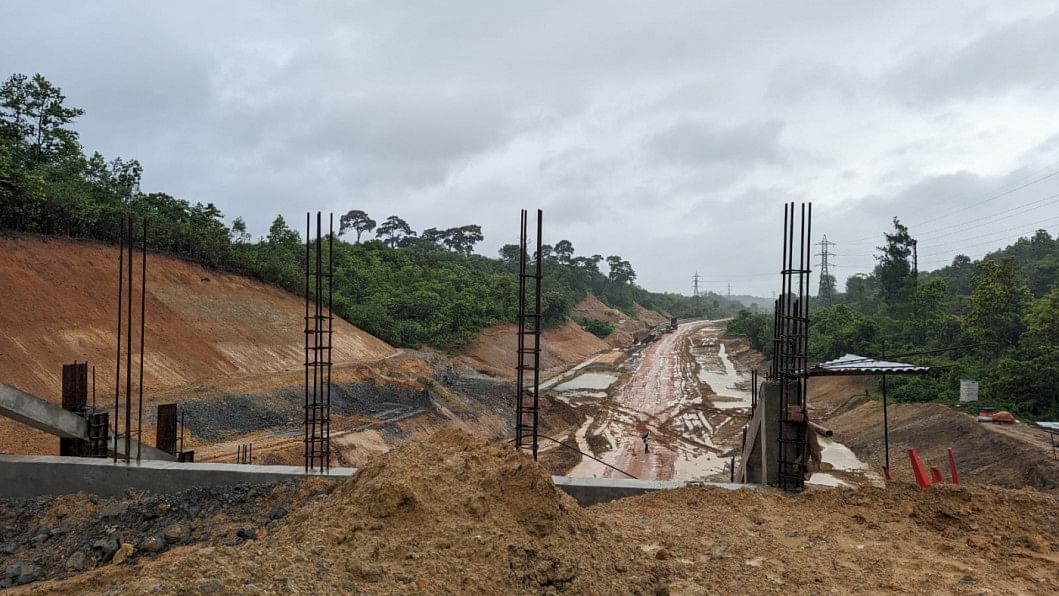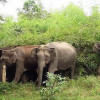Dohazari-Cox’s bazar rail line: Asian elephants to face existential threat
The new Dohazari-Cox's Bazar railway line, which cuts through three forested areas, is likely to obstruct the free movement of the critically endangered Asian elephants that use these forests as corridors.
Elephant specialists and forest officials say that corridors are vital to the existence of elephants that use them to move from one habitat to another in search of food and water. They believe that the overpass and underpasses built by Bangladesh Railway to facilitate the elephants' movement are inadequate and will pose a threat to their existence.
Out of the 102-kilometre rail line, 27 kilometres traverse through the Chunati Wildlife Sanctuary, the Fasiakhali Wildlife Sanctuary and the Medhakoccopia National Park--three important habitats for the Asian elephants in the Chattogram-Cox's Bazar region. These corridors were first documented in 2016 by the International Union for Conservation of Nature (IUCN) during a survey on the number of elephants in the region.
The government de-reserved 276 acres of forest, felled 7,20,443 trees and cut portions of 26 hills in 2016 to facilitate the construction of the rail line, according to an inventory report prepared by the forest department.
The construction of the Dohazari-Cox's Bazar railway began in March 2018.

As part of the ongoing construction of the rail line, Bangladesh Railway has built one overpass and two underpasses, as suggested/prescribed by the project's funding partner, Asian Development Bank, according to sources with knowledge of the project.
Elephant specialist H M Raihan, who was also a member of the IUCN's Elephant Route Identification Study for Single Line Metre Gauge Railway in 2014, told The Daily Star that in the study they found 16 crossing points of elephants along the 27-kilometre track and suggested building overpasses at 13 of them.
"Our recommendation was thorough. But the railway chose to reduce the number of overpasses. In fact, the reduction of passageways will increase elephant-train collisions and will pose an existential threat to the animal. The Asian elephant will disappear within ten years," said Raihan.
Echoing Raihan, Syed Mahmudur Rahman, mammologist of Bangladesh Forest Department, said the railway did not heed the suggestions they had made regarding the overpasses.
"The height of the underpasses they have built is not enough for large animals like elephants to pass through," he added.
In 2018, ADB's international consultant Noris L Dodd and national consultant Asif Imran conducted a Baseline Biodiversity Assessment (BBA) which was aimed, among other goals, at assessing the project's impact on the forested areas' biodiversity and developing "a strategy to enhance Asian elephant habitat quality/connectivity and reduce human-elephant conflict as project mitigations and conservation offsets."
The final BBA report recommended the construction of one overpass and two underpasses, which contradicts the suggestion made by elephant experts and forest department officials.
Rafiqul Islam Chowdhury, divisional forest officer (DFO) of Chattogram Wildlife and Nature Conservation Division, told The Daily Star that the railway officials did not bother to have any dialogue with them about the overpass and underpasses, and the construction of other passages.
Meanwhile, Bangladesh Railway has changed the design of an overpass it built near the Sathgor area of Chunati Wildlife Sanctuary. They built a rectangular box culvert instead of a large bridge structure which had been originally planned.
Asked about what role ADB played as the funding partner in monitoring whether the original design for the overpass was followed accordingly, an official from the ADB, requesting anonymity, told The Daily Star that their role is not punitive, rather it is corrective.
"We review the project, identify problems and ask the government to correct things that we think are going wrong", he said.
ADB consultant Asif Imran claimed that the three passageways -- one overpass and two underpasses -- the ADB-commissioned BBA report recommended were enough to accommodate the movement of the Asian elephants that roam these forests.

"We suggested building two underpasses and one overpass only in Chunati Wildlife Sanctuary, which are active crossing points," he added.
Green fencing and sensors will be used to prevent the elephants from falling into the craters created by excavations carried out for laying down the tracks.
Elephant expert H M Raihan, however, said the only option to save the elephant was to build overpasses at every crossing point. He opined that the green fencing won't help much.
Mofizur Rahman, project director of Dohazari-Cox's Bazar Rail Line, said the current design is much better than the previous one and that it cost them less and is more environment-friendly.
"We built one overpass and two underpasses based on the report of ADB. We did not decide on our own", he added.

 For all latest news, follow The Daily Star's Google News channel.
For all latest news, follow The Daily Star's Google News channel. 






Comments